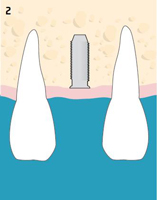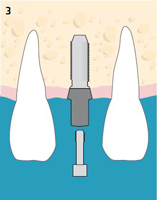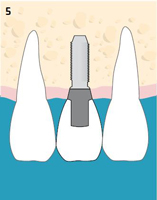A dental implant is a permanent replacement for a missing tooth. An implant screw is screwed into the jawbone to replace the missing tooth root. An abutment, a connecting piece, is placed on the implant screw, and an individually crafted dental crown, bridge, or removable dental prosthesis is attached to this abutment.
Treatment with implants usually begins with a consultation with the dentist. Dentists at Classensgade have extensive experience in aesthetic and reconstructive dental treatment, and implants are one of several options considered in relation to other alternatives. The treatment requires that the bone in the area is suitable for the insertion of a screw. This is typically assessed based on an X-ray and a clinical examination. If it is determined that the bone is not immediately suitable for the insertion of an implant, a surgical bone augmentation can be performed. As an alternative to treatment with an implant, a prosthesis can be made or a bridge can be created. A prosthesis is one or more artificial teeth attached to a base that rests on the gums. A tooth bridge consists of a number of tooth crowns that are connected and attached to the remaining adjacent teeth.
An implant is made of titanium, which is a very tissue-friendly material that the body does not react negatively to (foreign body reaction). The dentist places the implant by making a small incision in the gum and then pre-drilling a small standardized hole in the jawbone with a specially calibrated drill. The implant can then be mounted in the prepared hole. A small healing screw is placed on top of the implant, which usually protrudes through the gum. The gum can then be stitched back in place with a few stitches. Depending on which tooth is being replaced by the implant, a temporary smile prosthesis can be made to temporarily replace the missing teeth until a permanent implant-supported solution can be created. The entire procedure usually takes between 1-2 hours.
After the implant is placed
Once the implant is securely in the bone, something can be placed on top. An intermediate piece, also called an abutment, is inserted into the implant. On top of this abutment, what should resemble teeth can then be placed - either crowns or a removable denture. As implant treatment has become more and more common, there are incredibly many different brands of implants on the market, some better than others. At Classensgade Dentists, we have chosen to use one of the oldest and most proven implant brands. We have done this because we are convinced that we will not compromise on the quality of the treatments we provide. However, quality comes at a cost - unfortunately. It is therefore easy to find dentists who offer implant treatment cheaper than we do. However, you will not find dentists where the quality is higher.

Implant is on its way to being screwed into the hole in the bone

Implant in the bone
Swelling after an implant surgery is completely normal. It is a natural reaction from the body as it heals where the implant screw has been inserted. If you have also undergone bone grafting, the swelling is typically more pronounced. Therefore, it is important to take the prescribed pain medication, as it not only helps alleviate any pain but also reduces swelling. Additionally, you can apply an ice pack or something cold to the cheek to reduce swelling, and you should keep your head elevated in the first few hours after the procedure. The timing of when you can start eating and drinking after the procedure is individual and something you will be thoroughly instructed on when you are at the clinic.
The first few weeks after an implant surgery are crucial for healing. If bone grafting is required in connection with an implant treatment, medication is typically prescribed. The medication is aimed at preventing inflammation in the area to provide the best possible conditions for bone formation.
For more information for patients after surgical procedures, you can visit the following link: Guidelines After Surgical Procedures
Before the surgery, we recommend that you take some painkillers at the clinic. The surgeon will administer a large amount of local anesthesia so the procedure itself is completely painless. The anesthesia will typically last for 2-3 hours after the surgery is completed. The painkillers you took before the surgery will then take effect as the local anesthesia wears off. We recommend taking the maximum dose of painkillers for the first 3-4 days - it is easier to keep the pain under control than to combat it once it has occurred. Additionally, as mentioned earlier, they help reduce any swelling that may occur afterwards. The typical medications will be paracetamol (Panadol) and ibuprofen.
Depending on the nature of the operation, the threads will either dissolve on their own in 15-20 days or you will need to go to the clinic to have them removed. In that case, the area will be checked at the same time. How this will be done in each situation will be informed in connection with the procedure.
Typically, it will take 2-4 months for the implant to fuse with the bone. To verify whether the bone has integrated around the implant, an X-ray is taken and some clinical examinations are performed.
If it is determined that the implant is securely in place as expected, the abutment and crown/prosthesis can be attached.
The abutment serves as an intermediary from the implant in the bone up to the crown or prosthesis. The abutment is attached to the implant with a small screw and is typically made of titanium, like the implant. In some cases, the implant is hidden under the gum during the healing period, so a small incision in the gum is necessary to access the implant and place something on top.
To create the individually crafted tooth replacement - crown/bridge or prosthesis - an impression of the teeth and implant must be taken. If crowns or bridges are to be made as the final solution for the implants, the final solution is typically ready 2-3 weeks after the impression is taken, while in some cases it may take a little longer if it is a removable prosthesis.

Abutment mounted on implant
The crown or bridge is typically ready within 2-3 weeks after the impression is taken. If it is a very aesthetically demanding treatment, there will typically be 1 or 2 consultations with the dental technician who manufactures the crown. This is to ensure they know exactly what color the tooth should have and that they can personalize it to fit the individual case.
Today, crowns and bridges are usually made of porcelain. However, if there is a need to replace many teeth, it may be necessary to make a metal framework (titanium or Cobalt Chrome) under the porcelain. The choice of material depends on the specific requirements of the situation. If a front tooth needs to be replaced, it is important to choose a highly aesthetic material, while for the back molars, the material needs to be very chew-resistant.
If the missing teeth need to be replaced by a prosthesis, there is typically already a prosthesis in place, into which snap fasteners are then inserted to ensure a secure fit and prevent rocking or looseness.
In other cases, a completely new prosthesis is made after taking impressions of the implants. The specific treatment will be discussed before the treatment begins.

Crown securely placed on the implant
On the same day as the implant surgery, we recommend that you skip brushing and cleaning your teeth in the evening. The next day, you can start with regular tooth brushing, but avoid the operated area. Instead, rinse with a mouthwash called chlorhexidine (0.2%). Rinse twice daily for about 1 minute, keeping the liquid still in the area. There is no need to "gurgle" or do anything else actively. Spit out the liquid after 1 minute. This will keep the area clean while allowing the gum and bone around the implant to heal. Mouth rinsing should be done for a minimum of 1 week, but you will receive further instructions during the operation.
If you have been given a temporary denture, we recommend that you avoid using it for at least 2 weeks after the operation. Keep the denture clean by brushing it with a clean toothbrush and warm water with soap.
Once the rinsing with chlorhexidine is no longer necessary, you can lightly brush the area. Teeth and gums in the area should be kept clean to avoid the risk of infection.
It is very important that you keep the area around your new implants clean as good hygiene is a prerequisite for a lasting result. If the new teeth are not kept clean properly, there is a risk of developing inflammation in the gums and bone around the implant. This condition is called peri-implantitis and results in bone loss around the implant screw. As a result, the implant no longer sits properly, and the condition may ultimately lead to the need to remove the implant, indicating a failed treatment that needs to be redone.
In general, cleanliness should be maintained in the same way as around regular teeth. This means it is important to brush with a regular toothbrush and to clean between the teeth/implants with small interdental brushes. The specific steps to be taken in each situation will be discussed during the fitting of the final construction. If in doubt, you are always welcome to contact the clinic to discuss the best way to maintain cleanliness in the given situation.
* Photos show treatment performed at Tandlægerne i Classensgade.
** Illustrations borrowed from tandlaegeforeningen.dk